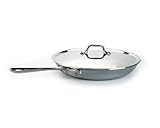Stainless Steel Cookware
The benefits of stainless steel cookware are known to all professional chefs. Stainless steel is unsurpassed for browning and it is extremely durable.
Browning is important for caramelizing vegetables and searing the juices into meat. The small bits of food left on the bottom of the pan after browning are essential to the creation of delicious sauces and gravies.
You may hear chefs on blogs and food shows talking about stainless steel being best for "fond". Fond is a French term for base - the foundation of stocks, broths, and demi-glaces. Fond is made from 'sucs' (pronounced sook, from the French word for sugar, sucre), the tiny bits of food that carmelize and stick to the bottom when you pan sear meat, poultry or fish. Add water, broth or wine to the pan and use a spoon to "deglaze" those little browned bits from the bottom. Most will dissolve and the rest can be strained out. This fond will produce a very flavorful sauce or gravy.
When you cook in a cast iron pan, a small amount of iron leeches out into the food. While this iron is good for you it can depart a very subtle metallic taste to your food. Not so in stainless steel. Food browns evenly and the "sucs" that adhere to the bottom will provide a very clear and honest taste that is valued by good cooks.
If you do not want food to stick, just season your pan. The method used to season is slightly different from what you do to season cast iron. Heat oil in your stainless pan to smoke level, then add 2 - 3 tablespoons of salt. Rub vigorously with a thick wad of paper towels, then wipe clean.
When you cook food in your pan, follow the old adage, "hot pan, cold oil, food won't stick". Heat your pan to a high temperature. Then lower the temperature, add your oil and immediately add your food. Contrary to popular myth you do not need a lot of oil to cook in stainless, but your oil does have to be at the right temperature.
It also helps to keep the outside of the pan free of burn marks and dark areas as they can cause uneven heating and the potential for hot spots inside the pan where the food will stick.
As with cast iron, just wipe your seasoned stainless steel pan clean after each use.
While food does stick to unseasoned stainless steel, its tough construction can stand up to heavy cleaning. It can soak in hot sudsy water, go into the dishwasher, and take on some serious scrubbing. However, as with any good pan you do not want to use harsh abrasives or brillo on the inside. Manufacturers recommend Bar Keepers Friend, Penny Brite or Bon Ami cleansers, and a nylon scrubbie.
Two stainless pots well worth the investment (and often on sale for 50% off at Amazon) the All Clad 12" fry pan on the left, and the All Clad 6 quart saucepan on the right.Click on each picture to go the Amazon page for that item, and read all the reviews.
 Another excellent name in professional cookware is Fissler. This German made product is investment quality. That is, not only is it top of the line for performance, it is beyond durable - you will never need another pot of this type for the rest of your life and will likely pass it on to your children.
Another excellent name in professional cookware is Fissler. This German made product is investment quality. That is, not only is it top of the line for performance, it is beyond durable - you will never need another pot of this type for the rest of your life and will likely pass it on to your children.
What to look for when buying Stainless Steel Cookware:
Construction, construction, construction.
Avoid 100% stainless steel cookware. Stainless has the worst thermal conductivity of all cookware metals. If a pot is 100% stainless it must be so thin to transfer heat from a stove to the food that it will warp.
Look for stainless cookware with a layer of aluminum sandwiched in a thick disk at the bottom of the pot. In fact one of the best types of cookware on the market is tri-ply aluminum core stainless.
Some stainless has a layer of copper either alone or with aluminum. Copper is the best thermal conductor of heat, but needs to be 2.5 to 3 ml thick to be effective. There is currently no stainless cookware on the market that has copper disks that thick. Most pieces advertised are too thin to make a difference.
Thick aluminum sandwiched in stainless is almost as good as thin copper when it comes to conductivity, with much less weight.
Rivets hold your handle to the pan. You want to inspect your pan to be sure the rivets are solid, and strong, and do not stick out or have grooves that will harbor food and germs.
When buying a large pan, get one with a handle to grip on both sides, for safety putting food in and out of the oven.
Do not buy a set. Buy the pieces you need and will use often. Check Amazon frequently for their good deals, and look for mark downs in Marshalls, TJ Maxx, and Home Goods.
Like cast iron, stainless has its fans - and people who try and do not like the cookware at all. Check your local Goodwill and Salvation Army, as well as garage sales, Craigslist and Freecycle for discarded quality stainless steel cookware and bakeware.
Tips and Tricks:
- Cold meat will stick to almost any pan. Take your meat out of the refrigerator at least 10 minutes before you cook it, and thoroughly defrost frozen meat.
- When you sear meat, it will bond to the bottom of the stainless steel pan until it is done browning. Keep checking by applying gentle pressure with a spatula, until the meat is finished browning and releases and moves freely.
- Do not use non-stick sprays as they will leave a brown stained residue in your pan that is extremely difficult to impossible to remove.
- You can use an oil mister on your pan. These are the type you fill with olive oil then use a pump action to create pressure for the spray.
- Oil and butter, 50/50, will allow meat and poultry to brown more slowly and help prevent scorching.
- Never put a hot pan in cold water, as it may warp.



